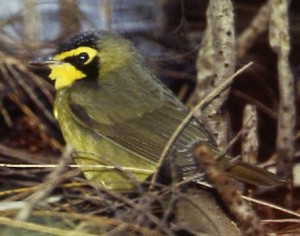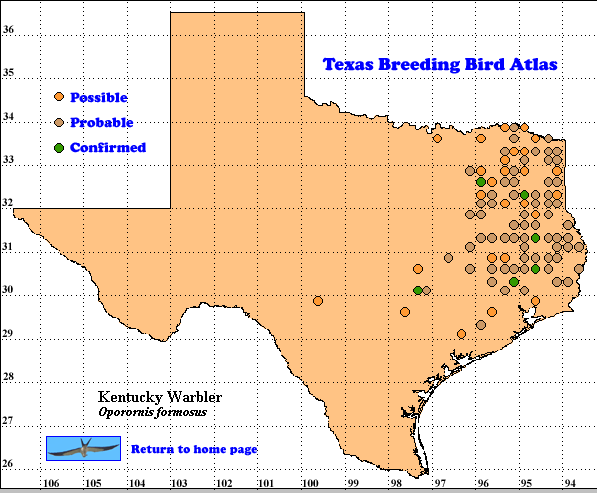The face pattern of the male Kentucky Warbler distinguishes it from other males of its genus: MacGillivray’s (Oporornis tolmiei), Mourning (O. philadelphia) and Connecticut (O. agilis) warblers, all of which migrate through Texas. In this genus sexual dimorphism is not striking although females and immatures are less boldly patterned than males (Pyle 1997, MacDonald 1998).
DISTRIBUTION. During the 1987-1992 TBBA field work observers found most Kentucky Warbler breeding records concentrated in the Pineywoods and part of the Post Oak Savannah and Blackland Prairies region east of the 96th meridian from the Red River to the Gulf Coast. Seven more records were obtained between the 96th and 97th meridians, mostly close to the 96th. Two confirmed and 1 possible record came from the latilong block northwest of the intersection of the 30th parallel and 97th meridian. Another possible record is just south of this block.
Outside Texas most Kentucky Warblers breed south of the Mason-Dixon line (the Pennsylvania-Maryland border) and east of the Great Plains. The species breeds regularly from western Iowa across Illinois, Indiana, Ohio, Pennsylvania and New Jersey, south to Georgia, the Florida panhandle, Alabama, Mississippi and Louisiana.
The species winters on the Gulf coastal plain of Mexico and south to Panama. Kentucky Warblers are also found in smaller numbers in Colombia, Venezuela and some islands in the Caribbean in winter (MacDonald 1998).
SEASONAL OCCURRENCE. Kentucky Warblers migrate north through Texas from March 18 to June 5 (peak early April to early May) and breed in Texas from late April to mid-July (eggs collected May 6 to June 19). Southward migrants are present from July 17 to December 10 (peak late July to mid-September). There have been occasional sightings in Texas in winter (Oberholser 1974, Lockwood and Freeman 2004)
BREEDING HABITAT. Kentucky Warblers nest from sea level to 500 m (1700 ft) in Texas in deciduous woodland thickets and moist shady ravines. The bulky nest is built on or near the ground at the base of a bush, on low tree branches or in coarse grasses, where surrounding vegetation conceals it. The nest is a loosely constructed cup of grasses, plant fibers and rootlets on a foundation of as many as 200 dead leaves, 10-15 cm (4-6 in) deep. It is lined with rootlets; forb stalks and grasses sometimes extending slightly above ground level.
The female usually lays 4-5 (range 4-6) white to cream white eggs and incubates them for 12-13 days. Nestlings usually leave the nest 8-9 (range 7-10 days after hatching. Kentucky Warbler is a frequent host of Brown-headed Cowbird (Molothrus ater); 3 cowbird eggs in a warbler nest are not unusual (Oberholser 1974, Harrison 1979, MacDonald 1998).
STATUS. Comparison of the TBBA map with that of Oberholser (1974) suggests the breeding range of Kentucky Warbler in Texas has shrunk in recent years. While the earlier map shows breeding records west to the 100th meridian, the TBBA map shows only 1 possible record west of the 98th meridian and most breeding records east of the 96th meridian.
This range reduction is consistent with the North American Breeding Bird Survey (BBS) data from the 23 routes on which the species was recorded in Texas. In the Pineywoods region 1-3 Kentucky Warblers were detected per route and <1 in adjacent parts of the Post Oak Savannah and Blackland Prairies. BBS trend data suggest the population in Texas has declined very significantly over the 1966-2003 period. The statistically significant population decline of 5.7% per year indicates the breeding population of Kentucky Warblers in Texas may be only 10-20% of the 1966 population. Nationally the statistically significant trend is -1.0% per year for this period (Sauer et al. 2004).
BBS data also suggest Texas represents only about 3% of the breeding range of the Kentucky Warbler; the species was recorded on 728 BBS routes across the United States, nearly 32 times the number of routes on which it was found in Texas (Sauer et al. 2004).
Lockwood and Freeman (2004) describe Kentucky Warbler as a rare to locally uncommon summer resident of the eastern quarter of the state, locally west to Bastrop, Grayson and McLennen counties. The species is an uncommon to common migrant in the eastern third of the state, less common going west.
While the status of Kentucky Warbler as a migrant in Texas will change very gradually, its breeding range and population in the state seem to be decreasing more rapidly. The Kentucky Warbler may disappear as a breeding species in Texas in the foreseeable future. Text by Robert C. Tweit (2005)
Literature cited:
Harrison, H. H. 1979. A field guide to western birds’ nests. Houghton Mifflin, Boston, MA.
Lockwood, M. W. and B. Freeman. 2004. The TOS handbook of Texas birds. Texas A&M University Press, College Station.
McDonald. M. V. 1998. Kentucky Warbler (Oporornis formosus). In The birds of North America, No. 324 (A. Poole and F. Gill, eds.). The Birds of North America, Inc., Philadelphia, PA.
Oberholser, H. C. 1974. The bird life of Texas. University of Texas Press, Austin.
Pyle, P. 1997. Identification guide to North American birds, part 1. Slate Creek Press, Bolinas, CA.
Sauer, J. R., J. E. Hines, and J. Fallon. 2004. The North American Breeding Bird Survey, results and analysis 1966-2003. Version 2004.1. USGS Patuxent Wildlife Research Center, Laurel MD (Web site, http://www.mbr-pwrc.usgs.gov/bbs).

